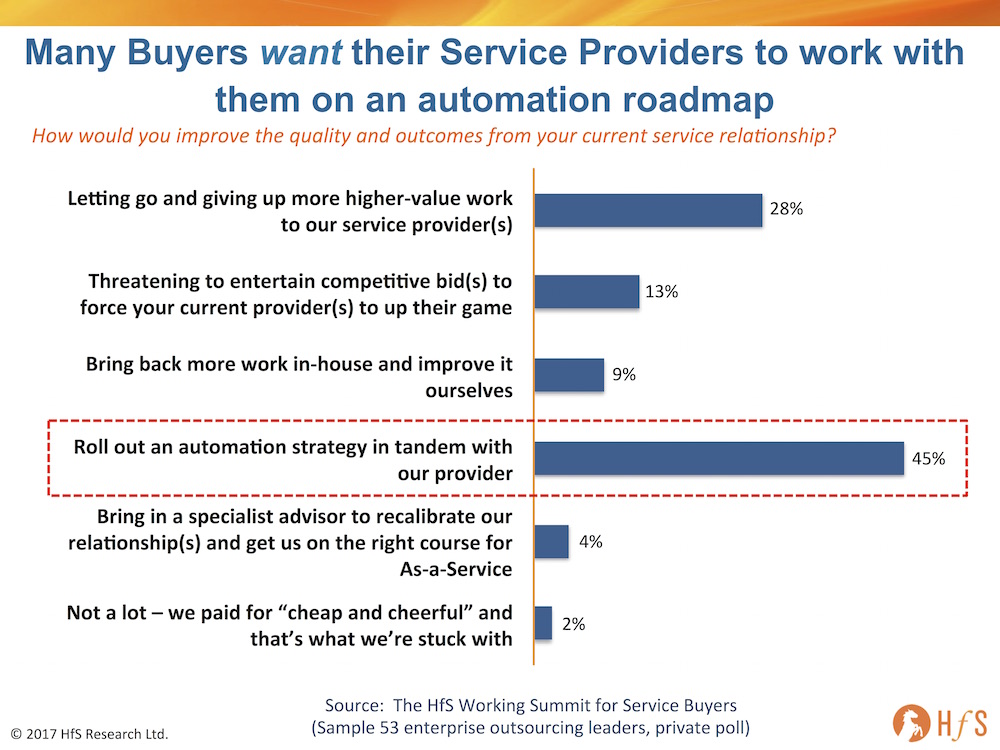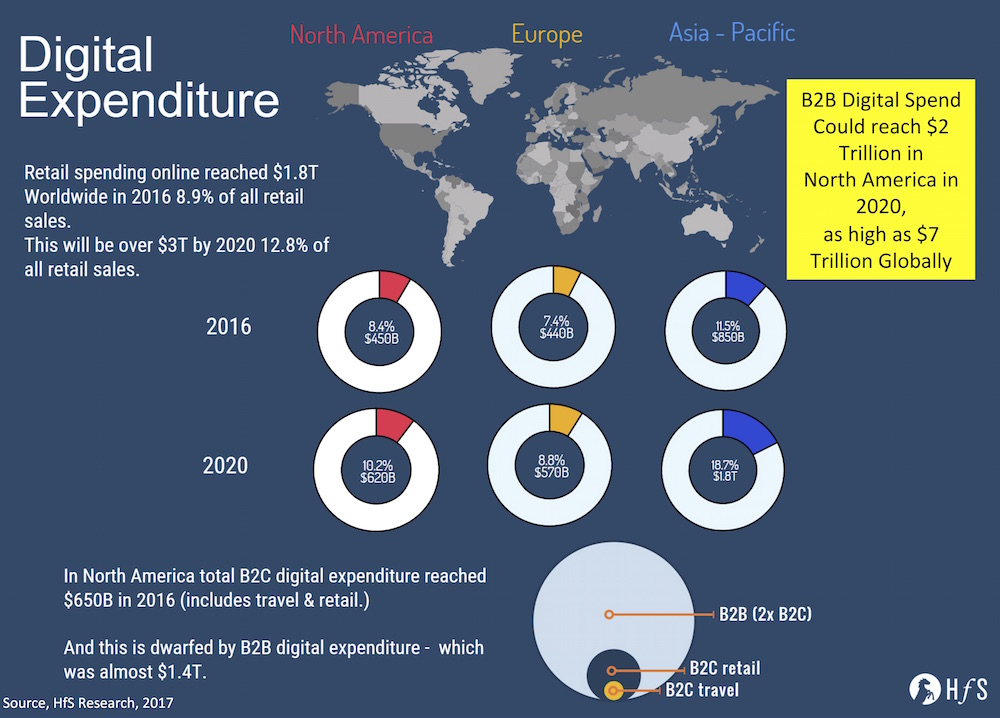 When, in history, has there existed a market that keeps relentlessly growing at 5-10% each year, with profit margins consistently at a 15-20% level; and for well over a decade? Yet you attend the annual flagship Indian IT conference only to experience an atmosphere of acute paranoia and paralysis. Is change really that frightening?
When, in history, has there existed a market that keeps relentlessly growing at 5-10% each year, with profit margins consistently at a 15-20% level; and for well over a decade? Yet you attend the annual flagship Indian IT conference only to experience an atmosphere of acute paranoia and paralysis. Is change really that frightening?
Even most clients are openly declaring they haven’t had their budgets reduced – many simply aren’t ready to make investments while there is such uncertainty surrounding the market because of an unpredictable US President. Even NASSCOM itself adds to the uncertainty by deferring its usual business outlook…
However, acting like a deer in the headlights is not an option. The smart strategy is to expect the worst and make measures now to get in front of it…. don’t let the juggernaut, that is a protectionist US administration, squash you flat in your tracks.
Breaking out of this paralysis cycle
However negatively this could turn out for some of the Indian IT services industry – here are six simple ways to break out of this paralysis and reinvest some of these bloated warchests, before greedy investors who got rich off your spoils demand to cash in their chips…
1) Invest internationally beyond the US. Those Indian IT majors in the strongest position are those that are least reliant on their US clientele for future growth. In fact, HfS estimates $7 Trillion in B2B digital expenditure by 2020 – with only $2bn being in the US (traditionally 50% of worldwide IT spend came from the US, but digital spending – both B2B and B2C – is changing that picture dramatically). For example, the British PM is already deep in discussions with Modi about closening UK/Indo ties even further in the wake of Brexit. The UK has the potential to become a major digital hub, fuelled by Indian talent. While Brexit appears like a terrible idea on paper, change forces action and these actions will be all about increasing the flow of trade and talent with emerging nations and creating new wealth. We also see a real appetite for digital business model investments and automation by Australian businesses – and many of the Asian nations are only too happy to move from zero to hero to take advantage of the humongous digital B2B expenditure in Asia/Pacific and the rest of the world.
In addition, many of the European regions, such as Nordics and Germany, are now rapidly exploring more global resources to support their digital growth. If America – as it appears – is on the path of becoming a protectionist anti-globalization country for the next four years, perhaps its time to broaden your horizons?
2) Invest in a smarter onsite/offshore model that gets you closer to your customer’s customer. Yesterday’s IT services model was all about helping legacy traditional enterprises keep their lights on by maintaining clunky old ERP implementations keep operating, adding extra sauce to spaghetti code and keeping an eye on server outages from afar. Tomorrow’s winners have moved all this stuff into the cloud and automated much of their infrastructure management. The future growth is working much closer to your customers to help them design and implement digital business models by building mobile applications, testing customer sentiment, forging partnerships and developing APIs with new digital business partners and communities. Technology skills such as DevOps, Agile, Hadoop, Blue Prism and AutomationAnywhere are the watchword, and a global race is on to access these skills. Moreover, the developers need to be closer to the business designers and customer strategies of the clients to make this effective. So Indian IT majors need to focus on developing these skilled resources where all their clients are situated, in addition to India itself. This will require re-investing some of that lovely cash sitting around – and, heaven forbid – take a small margin sacrifice for a few quarters.
3) Partner with digital agencies to get it done. Be realistic for once and accept the fact that most customers are not going to come to you to design highly creative digital business solutions. You have an IT services brand, not a creative digital brand. Most clients will go to the advertising firms, the Design Thinking consultancies and the digital specialists for that work. However, all those firms are pretty clueless when it comes to actually communicating their business designs to technology firms and having them just get it done. This is where you can really do well – by working with these agencies and consultancies as their IT partner – bring them into your clients and they will being you into theirs! Believe me, most the digital firms worth acquiring have already been hoovered up by the Accentures and Deloittes… most the stuff left on the market is overpriced, too small, and most their nose-ringed designers will jump ship the moment you buy them.
4) Become great intelligent automation intermediaries to manage broad automation and analytics environments for enterprises. Clients are crying out for providers to partner with them on their automation journeys – in fact, 45% of buyside operations leaders, when polled privately, view rolling out automation in tandem with their service provider as adding the most quality to their service relationship (see below). Several of the leading Indian heritage IT services firms are making impressive strides with their enterprise analytics and automation solutions – such as Infosys with MANA, TCS with ignio and Wipro’s Holmes – the key now is their ability to twin their solutions with the cream of the third party intelligent automation apps, such as AutomationAnywhere, Blue Prism, Pega, UiPath, Workfusion, Redwood, Antworks etc to become their clients’ intermediary for automation and analytics value. While some proprietary tools and bots can add great value, especially when aligned to specific industry processes, clients want to have the choice of adding their own independents tools to enjoy the biggest impact on their process value. The Indian IT leaders need to become great partners and facilitators in these emerging environments – they have the development talent in spades and the passion to bulldoze their way to the front of this market.

5) Keep investing in start-ups. One of the best cultural shifts in the Indian IT industry in recent times has been the emergence of the start-up scene in Delhi, Mumbai, Bangalore and other areas. Ambitious Indian IT talent is no longer desperate to walk that slippery steep treadmill of the IT juggernauts – many of whom are already too big, clunky and corporate for their own good. Moreover, tech investors are fed up having to invest $20-100m in US start-ups to develop one product or technology, when you can get the same value from the likes of India, China or Eastern Europe for a fraction of the cost. Having heard about the 400+ emerging startup firms who are already members of Saurabh Srivastata’s network (the original founder of NASSCOM), it gives me real hope for India’s future that the next generation of IT talent is already being healthily incubated.
6) Just make a plan and stick to it. The one big element of NASSCOM which I found most infuriating was the lack of a plan from most of the service providers. Most are simply playing a game of denial and react. This is a recipe for failure. Accept the fact there will likely be some uncertainty for six months before some new draconian measures are forced on businesses seeking to do business with the US. Net-net, it’ll be more expensive to deliver services to US clients and also harder to send your own talent over there to train US staff and manage projects. So set aside funds to hire more people in the US and budget for a margin squeeze on future US contracts. And forecast a 10-25% hit on deal flow due to longer decision cycles and US clients veering away from using highly visible offshore services suppliers.
Bottom-line: Take the tough blows now to roar to the front of the global IT industry when sanity returns
While the global IT world waits with baited breath, paralyzed by the ramblings of an unstable and determined US President, our beloved IT services firms can either remain numbed by fear, or actually use this opportunity to make some key strategic investments and initiatives. Those mountains of cash need to be used sensibly before those greedy investors demand their piece back, so act now, swiftly and decisively to organize an IT business that isn’t so reliant on lifting and shifting labor to and from the US, and puts you in the driving seat to lead in the $7 trillion dollar digital world, where automation is native and access to skills absolutely critical. India has a great shot at emerging as the world’s great IT pioneer, and so much more than a low cost labor provider for greedy legacy US corporates. Trump won’t be around forever, and he might actually be doing India a massive favor without ever realizing it…
Posted in : Business Process Outsourcing (BPO), Digital Transformation, intelligent-automation, IT Outsourcing / IT Services








Nicely covered Phil Fersht!
Phil really well said !! completely agree !!
Phil,
A compehensive and excellent analysis. The advice to focus on non-US locations and investments in automation platforms and startups is very sound.
Paul Keane
Smart and accurate! Well done as usual!
Phil – great insights as usual and stuff that we are totally focused on
Learning from the Guru… very powerful advice
Very pertinent in calling out the fallacy of the ostrich like attitude and providing insights on the way forward.
totally agree with you Phil. IT industry should use this as an opportunity to make strategic investments and take new initiatives.
Also important to do up your contingency plans. Things could move rapidly in uncertain directions.
Brian
Phil –
We all know that BPO/BPS exist because of lack of, broken and/or unclear business processes plus lack of delivering on this IT promise (straight through processing) had the business processes actually been clear… It has been a tactical approach to meet the business case, but the pain and root causes haven’t been eliminated.
1. Focus not only on US. Agree, still – from a language and culture perspective I see UK and USA have been driving this market. The offshore geo’s have picked it up – not sure they can drive a change in geo focus
2. Totally agree – We all went a little too long on the offshore approach I think
3. (in combination with your bullet 5…) Yes, the Design Thinking, Disrupters, Start-up’s and so – have a totally different approach to product/service design, mobility/digital first and they thing ‘touchless’ upfront. CIOs struggle here… and they struggle to write off legacy/re-invent, as they for years have been on a capex model – justifying this.
4. Conceptually, the 3XA (Automation, Analytics + AI story) is good. At the moment, there is just a dance in the market… Who will lead, how to split the pie (e.g. software license approach on robust RPA vs. traditional labor). I have several conversations here that leads to ‘lets fix the underlying core’ (vs. RPA) and …’ AI is ‘core’ for our business…’ (service providers position here still unclear)
‘Denial or lack of plan’. I sometime think that because of inability to develop a new strategy and plan (legacy BPO was ‘taking orders’ – not creating a menu) – the industry jumps into denial (versus the other way around… denial leading to not developing a plan).
I hear the impact to offshore service providers. But, what is the impact on US based service providers…will the companies now have to look inward creating a boom for them I think that is still unclear.
Phil – Indeed it does seem that the Indian IT industry has been paralyzed by Trump.
Rajeev
This shift has been a long time coming. Living in the present, the opportunity ignores the importance of strategies to sustain growth. This is strongly inhibited by nationalized leadership but also open visibility to the real inner workings and status of the Indian enterprise. The chance is still there but it will require some humility and self investment, otherwise all will be lost. No plausible excuse will redeem you.
Jerry Durant
Nice points Phil … to the point, concise and forward looking !
Awesome article Phil, I always wonder how you gain this level of deep insights on Indian IT Services business. Liked to share my point of view with the below comments:
1. What we see today is a massive leadership failure, way back in 2010, all of us knew this Tsunami is coming but the greed factor on easy profits without betting on emerging technologies ruled over
2. On the client side, their success was limited to yearly negotiation of SOWs with decent discounts/freebies and focus was only to reduce the spend, so it is natural the buyer side now wants to partner with service provider since they have less exposure to under the hood work now and need serious help
3. There is a huge potential but highly challenging task ahead to make ‘Automation native to daily work’. The leaders need to go back to basics and be able to hear about the best of breed practices from those who have pioneered working around the Automation DNA.
Last but not the least, the conversation around ‘% Productivity Improvement’ needs to take a backstage to start with & what and how much % Automation needs to take a lead..
@Dwayne – There will certainly be some increased demand to review the capabilities of local US IT firms in light of the current climate – you can already see the ruralshore players all over this one. However, for the bread and butter stuff like app support and help desk, I can see most clients just using the support from offshore (as always)… it’s the higher level support, in areas like RPA, digital transformation and change mangement, where there will be issues with importing talent, and I see this as a boon for the US consultants with the local resources, such as Deloitte, Accenture, IBM (even though these firms will also suffer from the immigration issues, also being very dependent on India and Philippines). End of the day, the US clients will simply wind up spending more money for their IT… it’s too important to keep their businesses running, and they will have no choice but to stump up higher rates.
PF
Well articulated, i am sure in a given ecosystem, each will take it differently based on their existing learning curve, well its good to keep these points in our mind..Keep writing.
Regards
dinesh poduval